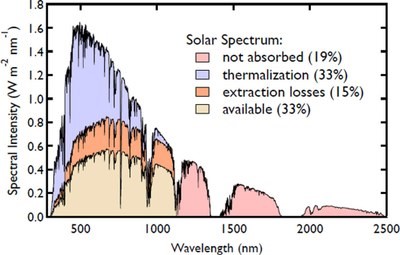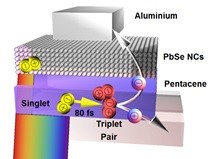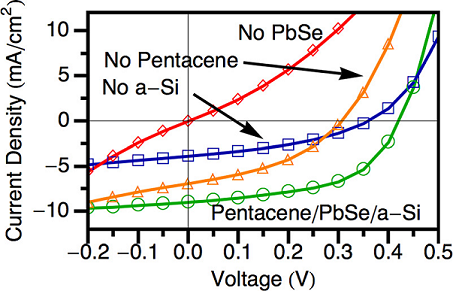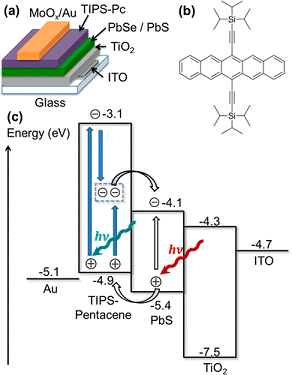Singlet Fission sensitised photovoltaic devices
All single junction PV cells developed to date share a fundamental energy loss mechanism -thermalization. This refers to the fact that the absorption of a high-energy photon generates one electron-hole pair just as the absorption of a low- energy photon does. The extra energy of photons above the bandgap is lost via relaxation to low frequency phonons and heat. This is the dominant loss in solar cells as shown in Figure 1, leading to the so-called Shockley– Queisser limit on efficiency, which is 33% for an ideal inorganic semiconductor cell (bandgap 1.1eV).

Figure 1: Losses in an ideal silicon cell leading to the Shockley–Queisser limit. Figure credit NREL
We aim to utilise some of the unique properties of the organic semiconductors to overcome the limitations of single-junction inorganic solar cells. Singlet fission (SF) (link to Ultrafast/SingletFission) is a process by which a high-energy singlet exciton, resultant from the absorption of a high-energy photon, is converted into two triplet excitons, each carrying about half the energy. Coupling such an organic semiconductor to a low band gap inorganic semiconductor allows fabrication of a two-bandgap solar cell in a single junction. In principle, these solar cells have an efficiency limit of 42%, which is about a quarter more than conventional solar cells. Our expertise spans from synthesizing the materials, fabricating the solar cells (we have filed 4 patents on different solar cell designs) and studying the fundamental photophysics of films and solutions by ultra-fast optical spectroscopy.

Figure 2: The concept of fission sensitised solar cell.
Examples of Singlet Fission Photovoltaics projects
- We have successfully demonstrated the use of a pentacene/nanocrystal singlet fission sensitizer for improving the efficiency of amorphous-silicon solar cells. We show that a thin layer of nanocrystals between silicon and pentacene allows simultaneously harnessing low-energy photons absorbed in silicon and high-energy photons absorbed in pentacene, generating two excitons via singlet fission.

Figure 3: The improvement of amorphous-silicon (a-Si) solar cells using a pentacene/nanocrystal (PbSe) sensitiser.
[1], Ehrler B. et al,., Hybrid pentacene/a-silicon solar cells utilizing multiple carrier generation via singlet exciton fission, App.Phys.Lett., 101, 153507 (2012)
- We are currently working on solution-processable singlet fission solar cells based on materials such as TIPS-pentacene. The first solution-processable singlet fission system we developed shows maximum power conversion efficiencies exceeding 4.8%, and external quantum efficiencies of up to 60% in the TIPS-pentacene absorption range. With PbSe nanocrystal of suitable bandgap, its internal quantum efficiency reaches 170 ± 30%.

Figure 4: (a) Device architecture of the nanocrystal/TIPS-pentacene photovoltaic device. (b) TIPS-pentacene. (c) Alignment of energy levels in the PbS/TIPS-pentacene device.
[2]. Yang L., et al., Solution-Processable Singlet Fission Photovoltaic Devices, Nano Lett. 15, 354 (2015).
